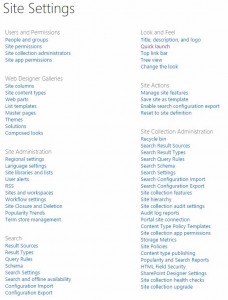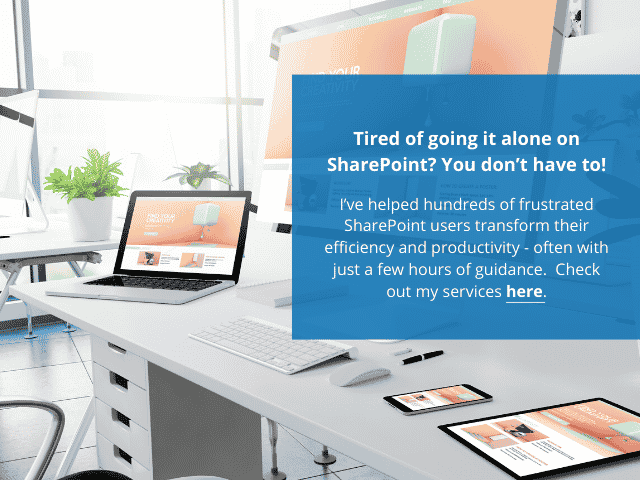5 reasons why you need a SharePoint consultant for your small business or a nonprofit
Your small business or a nonprofit has acquired Office 365 or SharePoint Online. Email accounts have been configured and working great, and now it is time to migrate documents to one central location so everyone can collaborate. You made it to the homepage of your newly setup SharePoint site. And that’s where the reality starts to settle in. For some reason, things don’t quite behave like they are supposed to. How do you utilize this supposedly super-capable tool and turn it into an efficient, productive, and collaborative environment in your organization?
You essentially have two choices: do it yourself or hire a third party SharePoint consultant.
With this blog post, I will try to answer a question I hear most frequently from small businesses and nonprofits: do we need to utilize SharePoint consulting services and hire an outside consultant when implementing SharePoint?
1. SharePoint is not DropBox
One big misconception I hear all the time is when people compare SharePoint to DropBox or Box.com or even network drives/file shares. Please don’t. DropBox and SharePoint had completely different evolution paths. DropBox was designed around simplicity, and its whole purpose was (cloud) file sharing and synchronization among various devices such as laptops, phones, and tablets. DropBox does it, and it does it pretty well, and its user interface resembles an already familiar folder structure, so from the user adoption standpoint, it is a relatively simple transition.
SharePoint, on another hand, was designed to be a completely independent ecosystem of components (web parts) to solve various business needs in large corporations and enhance collaboration at the enterprise level. It was not designed to be a storage solution. It has been around for more than a decade now and represents a very complicated system that can live and breathe on its own, as well as interface with many other business applications.
Want to learn more about SharePoint Document Management? Reference this post on “Document Management in SharePoint without folders – Introduction to SharePoint Metadata”
2. SharePoint was not initially designed for small businesses and nonprofits
Kind of related to a previous point, SharePoint was not designed and developed for small businesses and nonprofits. From its launch in 2001 up until 2011, it was sold and licensed as an on-premise solution to medium and large-size organizations. That meant you had to have a pretty serious infrastructure in place to be able to afford it. Only in 2011, when Microsoft has decided to bundle it with Office 365 cloud offering, it had become available and affordable to small organizations and nonprofits.
Medium and large-size organizations have staff and groups of employees dedicated exclusively to SharePoint. From infrastructure to administration to developers for building customizations and interfaces.
SharePoint was not designed to be a “plug and play” or “out of the box” solution. It was always assumed that some sort of configurations and standardization would be done before it is rolled out to employees. Therefore, out of the box, SharePoint is not the same user-friendly solution as say, DropBox.
3. SharePoint is a full-time job
If you think you can dump the files from your old network drive or DropBox into SharePoint, share URL with employees, and then you are done, then I strongly encourage you to cancel your Office 365 subscription and go back to whatever solution you had before. Trust me, you will save yourself from unnecessary stress.
If I were to compare Dropbox to SharePoint, it would be like comparing a bicycle to an airplane. The majority know how to drive a bike. Not many know how to fly an aircraft with its complicated technology and electronics. Think of SharePoint as an airplane – it is a complicated piece of machinery with sites, pages, web parts, apps, security, navigation, document management options, etc. Did I mention that you can write a separate book on any single thing listed in the previous sentence?
As a proof of reasons 2 and 3 above, here is a screenshot of what Site Settings Administration screen looks like. Does it all make sense to you? (click image to make it larger)
4. You can’t afford to get it wrong with SharePoint
Unlike Dropbox, where you create your account, download the app and go, SharePoint requires a long-term strategy before you move your first document into it. You need to brainstorm and think through information architecture, site navigation, sub-site structure, security groups and permissions setup, external sharing, metadata configuration, governance, and lots of other things. Ignore all of this, and your SharePoint will quickly turn into a dumpster like your current DropBox or file shares. It is always far better and more comfortable to start things on the right foot from scratch than fix an already existing mess.
For an example of things that can get wrong with SharePoint, reference one of my previous posts on “12 reasons folders in SharePoint are a bad idea.”
5. You can’t keep up with SharePoint evolution
SharePoint as a tool/technology does not sit still. It is constantly evolving with new web parts, applications (apps), and customization options. In the past, every new revision (i.e., SharePoint 2007, 2010, 2013) had its twists, user interface changes as well as new ways to do things. With the SharePoint 2013 Online/Office 365 bundle, its pace of changes has been accelerated as Microsoft is competing with Google Apps and other services. Moreover, when changes happen, you will have little control over it (remember, SharePoint is in the cloud, not on your server). No single person can be an expert in SharePoint – it is such a complicated technology that there are numerous LinkedIn groups, conferences, and meetups dedicated to it. So unless you spend considerable time in addition to your day job, you really won’t have time to learn it.
I hope you found this article useful. At the end of the day, whether you decide to hire an outside consultant or develop internal know-how and do it yourself – is your business decision. Successful SharePoint implementation depends on a variety of factors, and this post only addressed one little aspect of it.


